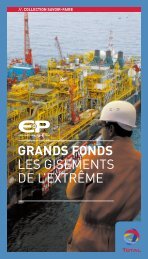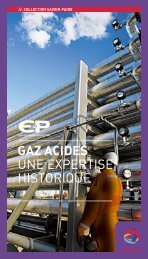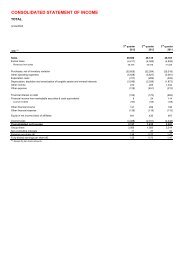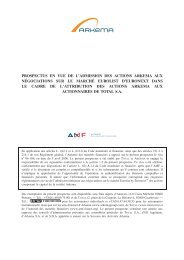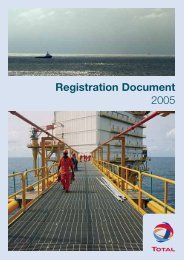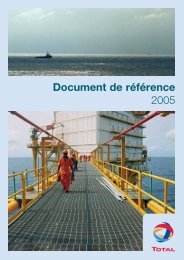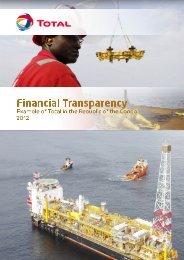Registration document 2007 - Total.com
Registration document 2007 - Total.com
Registration document 2007 - Total.com
You also want an ePaper? Increase the reach of your titles
YUMPU automatically turns print PDFs into web optimized ePapers that Google loves.
Environment<br />
Pursuant to French law No. 2001-420 of May 15, 2001,<br />
TOTAL S.A. is obligated to supply information on the social and<br />
environmental consequences of its activity, and to meet the<br />
requirements of the implementation decree of February 20, 2002,<br />
to provide information about the environmental objectives of its<br />
subsidiaries outside France. This information is specified in Article<br />
148-3 of decree No. 67-236 of March 23, 1967, as amended, on<br />
<strong>com</strong>mercial <strong>com</strong>panies.<br />
The following paragraphs present information on the environmental<br />
policy objectives proposed by the parent <strong>com</strong>pany. More detailed<br />
environmental information does not seem relevant for TOTAL S.A.,<br />
given, on the one hand, the type of activities conducted by it as a<br />
holding <strong>com</strong>pany, and, on the other hand, the type of activities<br />
conducted by the Group.<br />
The Group has operations in over 130 countries, in areas as<br />
diverse as the upstream and downstream oil and gas industry,<br />
energy production and chemicals. The Group’s social and<br />
environmental report Sharing Our Energies contains, in its section<br />
on the environment, detailed information on the way the various<br />
entities of the Group conduct their environmental policies. This<br />
report summarizes the consequences of its activities on the<br />
environment, describes and explains their qualitative and<br />
quantitative impacts, specifies the actions conducted, and<br />
presents the performance of the entire Group in environmental<br />
matters and the <strong>com</strong>mitments it has made or proposes to make.<br />
The Safety, Environment and Quality Charter constitutes an<br />
essential reference in the Group's culture and testifies to its<br />
<strong>com</strong>mitment to the safety of its activities, people’s health, respect<br />
for the environment, and the quality of its products and services.<br />
This charter, which is translated into several languages, should<br />
be appreciated in the context of the operational realities of each<br />
of its businesses.<br />
It is based on ten key principles which are detailed in an<br />
ac<strong>com</strong>panying guide that is designed as a support for managers<br />
to implement them into daily activities.<br />
The ten principles fall into three broad categories: the industrial<br />
activity itself, the employees and third parties:<br />
• As regards the industrial activity, no development project,<br />
no extension of an industrial facility, and no new product launch<br />
can be undertaken in any country where a Group subsidiary<br />
operates without a prior detailed analysis of the risks<br />
concerning health, safety and the environment within the<br />
business unit in question. Verification that these risks have<br />
been taken into account and the adoption of the necessary<br />
prevention, correction and <strong>com</strong>pensation measures is done at<br />
the time when the project is examined by the business units<br />
concerned. Major projects for investment, acquisitions and<br />
disposals are reviewed by the Group’s Executive Committee,<br />
having first been presented to the Group Risks Committee.<br />
This <strong>com</strong>mittee includes a representative of the Sustainable<br />
Appendix 3 - TOTAL S.A.<br />
Social and environmental information<br />
11<br />
Development and Environment department and a representative<br />
of the Industrial Safety department.<br />
This procedure for the evaluation and prevention of risks, prior<br />
to the <strong>com</strong>mencement of any project, relies on the scientific<br />
analysis of the substances used and produced and their<br />
effects, and on environmental impact studies and technological<br />
risk assessments, pursuant to the regulations in force in the<br />
countries of operation and the industry’s guidelines. In recent<br />
years, particular emphasis has been placed on health impact<br />
analyses and progressively incorporating the end-of-life issue<br />
for products and facilities. Close attention is also given to<br />
biological diversity, especially in areas of particular ecological<br />
sensitivity, identified with the support of scientific organizations.<br />
The Group’s sites in relation to ecologically sensitive areas are<br />
currently being mapped.<br />
These different aspects, with their highly scientific and technical<br />
<strong>com</strong>ponents, are an integral part of the decision-making<br />
process and are based on preliminary studies. Actions are<br />
currently underway within the business units to harmonize the<br />
methodologies on which these studies are based.<br />
Once the project has started, the valuation and prevention<br />
process is conducted regularly during the entire lifetime of the<br />
project, in order to verify that the impacts on the environment<br />
and safety risks are reduced as much as possible.<br />
In accordance with the Safety, Environment and Quality Charter,<br />
the prevention objectives are incorporated in the various<br />
environmental action plans established over two, three or more<br />
years, and cover the reduction of emissions of polluting<br />
substances into the atmosphere and water, reduction of<br />
consumption of water and certain raw materials, improvement<br />
of energy efficiency, reduction of the production of waste at the<br />
sites and recovery of the waste that is produced. Each<br />
business unit sets figures for certain target objectives for<br />
improving its environmental performance and circulates this<br />
information at its sites, based on the particular features relevant<br />
to each.<br />
Regarding greenhouse gas emissions, the implementation in<br />
2005 of the European Union CO 2 emissions quota trading plan<br />
represents a new stage in the policy to <strong>com</strong>bat global warming<br />
and constitutes a real technological challenge for the Group.<br />
In December 2006, the Group <strong>com</strong>mitted to reducing by 50%<br />
by 2012 the volume of gas burned at its exploration production<br />
facilities, taking the year 2005 as a reference. These<br />
greenhouse gas reductions and corresponding actions are<br />
detailed in the Group’s social and environmental report<br />
mentioned above.<br />
Close attention is also paid to soil and groundwater<br />
contamination, in the context of specific risk and pollution control<br />
assessment programs. Studies aimed at harmonizing the<br />
assessment methodologies and the criteria for drawing up action<br />
plans for pollution control are in progress.<br />
TOTAL - <strong>Registration</strong> Document 2006 279




